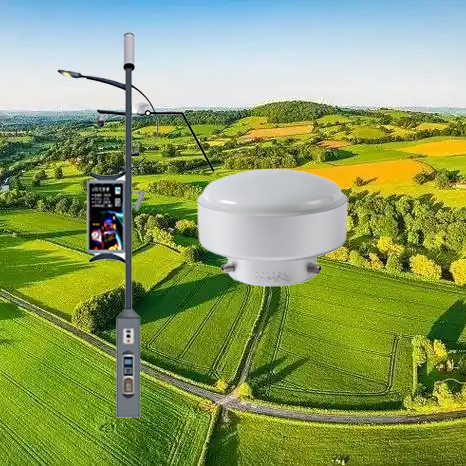Zuva: Ndira 13, 2025
Nzvimbo: Melbourne, Australia - Mukufambira mberi kukuru kwekurima kwakaringana, varimi vekuAustralia vari kuramba vachitendeukira kumajeji emvura eradar kuti vawedzere nzira dzavo dzekuchengetedza mvura uye kugadzirisa goho mukati mekuchinja kwemamiriro ekunze.
Sechinyakare, magaji ekunaya kwemvura anga ari iwo tekinoroji yekuyera kunaya kwemvura, asi kuvandudzwa kwezvino muradar tekinoroji kuri kuita kuti pave neruzivo rwechokwadi uye nenguva yekunaya kwemvura. Iwo majeji matsva emvura eradar anoshandisa Doppler radar masisitimu kuona hunyoro uye mafambiro emvura panzvimbo yakafara. Iyi tekinoroji inogona kupa ruzivo rwenguva chaiyo pamusoro pekunaya kwemvura uye kugovera, zvichiita kuti varimi vakwanise kuita sarudzo dzine ruzivo nezvemadiridziro, fetiraiza, uye kutonga kwezvipembenene.
"Nekusiyana kwemamiriro ekunze uye mamiriro ekunze ari kuwedzera kusagadzikana, kukwanisa kuwana data chaiyo yekunaya kwemvura munguva chaiyo yakakosha pakurima kwakasimba," akadaro Dr. Lisa Wang, nyanzvi yemamiriro ekunze uye nyanzvi yezvekurima paYunivhesiti yeQueensland. "Radar rain gauges rinopa ruzivo rwakakwana runobatsira varimi kuti vashandise mvura, kuderedza tsvina, uye kuwedzera hutano hwezvirimwa."
Kuvandudzwa kweData Kurongeka uye Kuziva Kwenzvimbo
Imwe yemabhenefiti akakosha ejeji remvura radar pamusoro pemaitiro echinyakare kugona kwavo kupa ruzivo rwenzvimbo. Mageji ekunaya kwemvura anongogumira pakuyera kuyerwa uye anogona kupotsa zviri nyore kusiyana kwakakosha pamadaro madiki. Kusiyana neizvi, tekinoroji yeradar inokwanisa kutora data rekunaya kwemvura munzvimbo dzakakura uye kugadzira mepu dzakadzama dzekunaya kwemvura, zvichibvumira varimi kuti vaone kuti mvura yakawanda yakanaya kupi uye rinhi.
Semuyenzaniso, varimi vari muMurray-Darling Basin, imwe yenzvimbo dzinokosha dzekurima muAustralia, vakashuma kuvandudzwa kukuru mumaitiro avo ekuchengetedza mvura kubva pakubatanidza magaji emvura eradar mukushanda kwavo. Nekushandisa tekinoroji iyi, varimi vanokwanisa kugadzirisa zvirongwa zvekudiridza zvichibva paruzivo rwekunaya kwemvura nguva pfupi yadarika, zvichiita kuti pave nemaitiro akanaka ekuchengetedza mvura uye kuwedzera kushanda zvakanaka mukushandiswa kwemvura.
Nyaya Yenyaya: Kutarisira Fetereza uye Goho reChirimwa
Kuiswa kwemaradar ekunaya kwemvura kwakaratidzawo kubatsira mukugadzirisa kushandiswa kwefetereza. Varimi vave kukwanisa kuronga nguva yekuisa fetereza yavo nemazvo vachitarisa kuti mvura ichanaya sei, vachiona kuti kudya kunotorwa nembesa zvine mutsindo kwete kukukurwa. Kurongeka uku hakungokwidzi goho chete asiwo kunoderedza kukanganiswa kwezvakatipoteredza kwefetereza inoyerera mumikoto yemvura iri pedyo.
John Carter, murimi wemupunga wokuNew South Wales, akataura zvakaitika kwaari achiti: “Kubvira patakatanga kushandisa zviyereso zvemvura zveradar, takaona musiyano unooneka mugoho redu remupunga.
Matambudziko Neramangwana
Nepo mabhenefiti eiyo radar mvura yegeji achizivikanwa zvakanyanya, kune matambudziko ekugamuchirwa kwakapararira, kusanganisira mutengo wepamberi wemidziyo uye kudiwa kwevarimi kuti vazive tekinoroji. Nekudaro, nyanzvi dzeindasitiri dzinotarisira kuti sezvo tekinoroji ichiva nyore kuwanikwa uye ichikwanisika, kubatanidzwa kwayo mukurima kweAustralia kucharamba kuchikura.
Hurumende yeAustralia iri kutsigirawo shanduko iyi, ichiisa mari muzvirongwa zvekutsvagisa zvekurima uye zvirongwa zvekusimudzira zvinosimudzira matekinoroji echizvino-zvino kusimudzira kusimba kwekurima mukushanduka kwemamiriro ekunze. Zvirongwa izvi zvine chinangwa chekuona kuti varimi vagone kushandisa ruzivo rwechizvino-zvino kuitira kuchengetedza goho vachichengetedzawo zvekushandisa.
"Sezvatakatarisana nematambudziko anokonzerwa nekushanduka kwemamiriro ekunze, zvakakosha kuti tiise mari mumatekinoroji anotsigira kurima kwakasimba," akadaro Gurukota rezvekurima, Senator Murray Watt. "Radar mvura yegeji inomiririra chikamu chakakosha chepuzzle, ichipa varimi ruzivo rwavanoda kuti vaite sarudzo vaine ruzivo uye vajairane nekuchinja kwemamiriro."
Mhedziso
Kubatanidzwa kwemajeji emvura eradar mukurima kweAustralia kunoratidza danho rakakosha rekuita kurima kwakasimba uye kwakasimba. Sezvo varimi vakawanda vanotanga kushandisa tekinoroji iyi, ine mukana wekugadzirisa zvakare magadzirirwo emvura, kuvandudza goho, nekusimudzira kusimba kwechikamu chekurima maererano nemamiriro ekunze ari kuramba asingatarisike. Nekufambira mberi nekutsigirwa kubva kuhurumende pamwe nenharaunda yezvekurima, ramangwana rekurima muAustralia rinotaridzika rinofambiswa nedata uye rakabudirira kupfuura nakare kose.
For moreradar rain gaugeruzivo,
ndapota taura neHonde Technology Co., LTD.
Email: info@hondetech.com
Webhusaiti yekambani: www.hondetechco.com
Nguva yekutumira: Jan-13-2025



